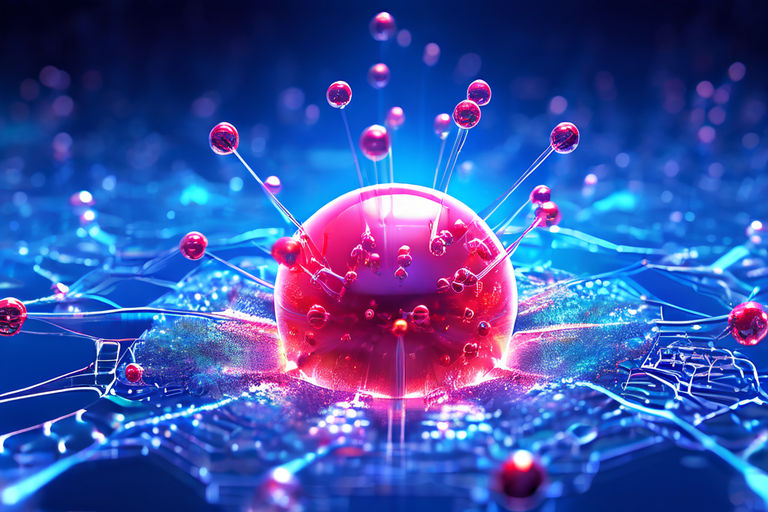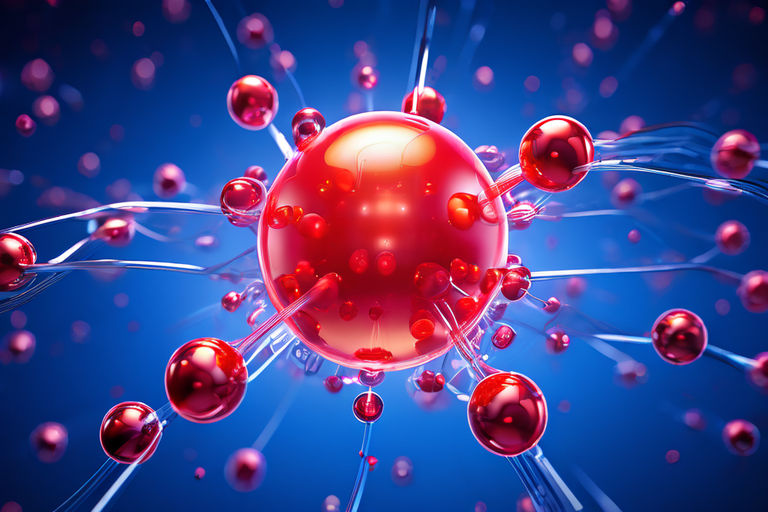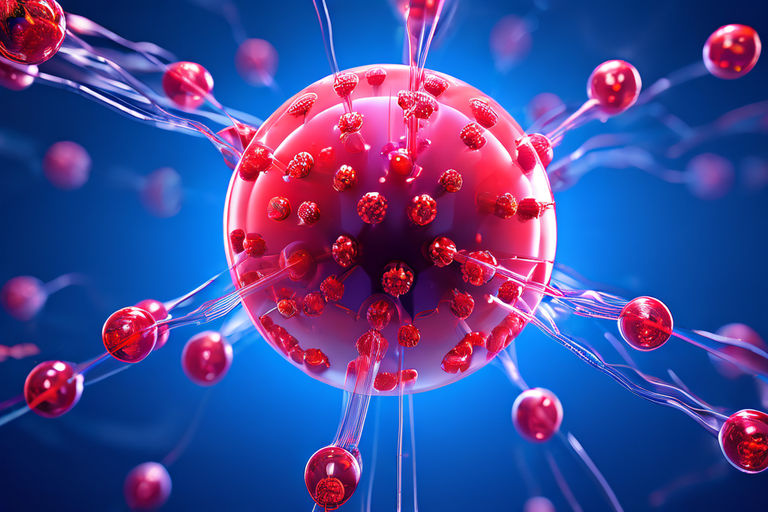Introduction
In the intricate landscape of cellular biology, the nucleus stands as a sentinel, orchestrating the symphony of genetic control within the cell. Its significance reverberates across various biological processes, from cellular reproduction to gene expression. Let’s embark on a journey to unravel the nucleus’s mysteries and understand its pivotal role in biology.
Understanding Nucleus
What is a Nucleus?
Think of the nucleus as the bustling center of a city, in this case the city being a eukaryotic cell. It is the headquarters, the control center where all important decisions are taken. This tiny organelle, surrounded by a protective membrane, contains the cell’s most valuable possession – its genetic material.
Just as a city mayor oversees various aspects of city life, the nucleus controls vital functions within the cell. It plays an important role in orchestrating growth, regulating metabolism and overseeing reproduction. Without a nucleus, the cell would lack direction and purpose, much like a ship without a captain.

Within the nucleus, you’ll find the cell’s DNA neatly packaged into structures called chromosomes. These DNA strands contain the instructions for building and maintaining the entire organism. Think of them as intricate blueprints that guide the construction of every molecular machine and biological process within the cell.
Furthermore, the nucleus is not just a passive bystander; It actively communicates with other parts of the cell, sending signals and receiving feedback to keep everything running smoothly. It is like a central communication hub, constantly exchanging information to maintain cellular harmony.
In essence, the nucleus is the beating heart of eukaryotic cells, directing their functions and ensuring their survival. Without these vital organelles, life as we know it would cease to exist. So, the next time you marvel at the complexity of living things, be sure to give a nod to the humble nucleus, quietly orchestrating the symphony of life within each cell.
Structure of the Nucleus
Nuclear envelope: Think of the nuclear envelope as a fortress wall that surrounds the nucleus. It is a double membrane structure that acts as a barrier, separating the nucleus from the cytoplasm of the cell. Like a security checkpoint, it carefully controls what enters and exits the nucleus, ensuring the safety of its contents.
Nucleoplasm: Inside the nucleus, there is a gel-like substance called nucleoplasm. Picture it as the filling inside a jelly doughnut. This fluid medium fills the interior of the nucleus, providing a supportive environment for the various functions of the organelle. Within this turbulent environment, important molecular processes occur that are essential for cell survival.
Nucleolus: Within the nucleoplasm, you will find a distinct structure called the nucleolus. It is like a mini-factory dedicated to producing one of the essential components of the cell – the ribosome. Just as a factory has specialized machinery for manufacturing products, the nucleolus contains the machinery needed to synthesize ribosomes. Ribosomes are crucial for protein production, so the nucleolus plays an important role in the cell’s ability to make proteins.
Chromatin: Finally, scattered throughout the nucleoplasm, you find chromatin. Think of it as a tangled ball of thread containing the cell’s genetic instructions. Chromatin is made up of DNA, along with proteins called histones, which help package and organize the DNA strands. These tightly packed structures ensure that long DNA molecules fit neatly inside the nucleus. When the cell needs to access specific genes for protein synthesis or other cellular processes, it can unfold and read the chromatin.
Together, these components form the complex machinery of the nucleus, working in harmony to regulate gene expression, produce essential cellular components, and maintain overall cell function. It is truly a remarkable feat of nature’s engineering!
Functions of the Nucleus
Think of the nucleus as the control center of a cell, like the brain. It is incredibly important because it contains all the instructions for how the cell should function These instructions are stored in molecules called DNA, which are like the cell’s recipe book for making proteins, the building blocks of life.
But the nucleus doesn’t just store these instructions; It involves putting them into action. It helps make something called ribosomes, which are like the protein factories of the cell. These ribosomes then follow the instructions from the DNA to make the proteins that the cell needs to survive and function properly.

And that’s not all! The nucleus has a major function in ensuring that cells divide properly. When cells need to reproduce themselves or replace old or damaged cells, the nucleus ensures that genetic material is divided correctly into new cells. This helps ensure that each new cell has all the correct instructions to function.
Nuclear Envelope and Pores
Composition of the Nuclear Envelope
Picture the nucleus of a cell as being surrounded by a protective barrier, like a castle wall. This barrier is called the nuclear envelope and consists of two layers like a double membrane. But it’s not just a solid wall; It is lined with tiny doors called nuclear pores.
These pores are like gateways that allow molecules to pass in and out of the nucleus, creating a passageway between the nucleus and the rest of the cell’s interior, called the cytoplasm. In this way, essential molecules such as proteins and genetic material can move back as needed for cell function.
What’s really nice about this barrier is that it doesn’t just let anything and everything pass. It is selective, meaning it only lets certain molecules through while keeping others out. This selective process helps protect the integrity of the genetic material inside the nucleus, ensuring that everything stays in its proper place and that the cell functions smoothly.
Role of Nuclear Pores
Think of atomic holes as bouncers at a club, controlling who goes in and out These tiny structures are like gatekeepers for the nucleus, the control center of the cell. They carefully direct the traffic of large molecules such as proteins, RNA and signaling molecules in and out of the nucleus.
The way these holes are made is quite amazing. They have a complex structure that allows them to be very selective about what they give away. This precision regulation is crucial to maintaining balance within the cell, keeping everything in order and ensuring that cellular processes run smoothly.
Nucleoplasm and Chromatin
Characteristics of Nucleoplasm
Think of the nucleoplasm as a thick, gel-like substance inside the nucleus of a cell. This gooey environment is full of all kinds of important elements that the nucleus needs to function.
One of the main things the nucleoplasm does is provide a sort of “home” for biochemical reactions to take place. These reactions are important for functions such as copying DNA (replication), reading DNA to make RNA (transcription), and repairing any damage that may occur to the DNA.
Significance of Chromatin
Chromatin is like a dynamic library inside the nucleus of a cell. It is made of a mixture of DNA and special proteins called histones. Together, they form a complex structure involved in controlling how genes are turned on and off, essentially controlling which sections of DNA are used to make proteins.
Think of chromatin as a switchboard for gene expression. When it is in its condensed form, known as heterochromatin, it acts like a silent mode for genes. This means that gene expression is turned off in this state, like turning off a light switch.
On the other hand, when chromatin is in its more relaxed form, called euchromatin, it is ready for genes to read and use. It facilitates the process of transcription, where information encoded in DNA is converted into RNA, which can be used to make proteins.
Types of Chromatin
Chromatin comes in two main flavors: heterochromatin and euchromatin. Think of them as two different states of a room—one tidy and quiet, the other open and busy.
Heterochromatin is like a tidy house. It is tightly packed and not very active in gene expression. Its main function is to maintain the stability of the cell’s genetic material, keeping everything neatly organized and in its place.
Euchromatin, on the other hand, is like an open and busy cell. It is in a more relaxed state, allowing gene transcription to occur. This means that genes within euchromatin are accessible and can be read by the cell’s machinery to make proteins. This is important for processes such as cellular differentiation, where cells specialize into different types to perform specific functions.
Nucleolus and Ribosome Synthesis
Function of the Nucleolus
The nucleolus serves as the epicenter for ribosome biogenesis, orchestrating the assembly of ribosomal subunits. Within its confines, ribosomal RNA (rRNA) genes undergo transcription, followed by processing and assembly into functional ribosomes.
Process of Ribosome Synthesis
Ribosome synthesis involves a complex interplay of molecular events, encompassing transcription, processing, and assembly steps. The nucleolus coordinates these processes, ensuring the efficient production of ribosomes essential for protein synthesis.
DNA and Genetic Regulation
Role of DNA in the Nucleus
DNA, the blueprint of life, resides within the nucleus, dictating cellular function through its encoded genetic information. The nucleus safeguards genomic integrity, orchestrating DNA replication, repair, and recombination processes.
Gene Expression and Regulation

Gene expression, the process by which genetic information is translated into functional proteins, undergoes meticulous regulation within the nucleus. Transcription factors and epigenetic modifications modulate gene expression, shaping cellular identity and function.
Transcription and Translation
Transcription, the synthesis of RNA from DNA templates, occurs within the nucleus, mediated by RNA polymerase enzymes. Subsequently, messenger RNA (mRNA) transcripts undergo processing and export to the cytoplasm for translation into proteins, underscoring the nucleus’s central role in protein synthesis.
Cellular Reproduction
Nucleus in Mitosis
During mitosis, the nucleus undergoes dynamic changes, condensing its genetic material into chromosomes and segregating them into daughter nuclei. This highly orchestrated process ensures the faithful distribution of genetic material to progeny cells.
Nucleus in Meiosis
Meiosis, a specialized form of cell division, involves two successive nuclear divisions, yielding haploid gametes essential for sexual reproduction. The nucleus orchestrates intricate events, including homologous chromosome pairing, crossing over, and chromosome segregation, ensuring genetic diversity and reproductive success.
Diseases and Disorders
Nucleus-related Disorders
Dysregulation of nuclear function underlies various diseases and disorders, including cancer, neurodegenerative diseases, and developmental disorders. Aberrant gene expression, DNA damage, and chromosomal instability contribute to disease pathogenesis, highlighting the nucleus’s vulnerability to cellular stress.
Implications in Cancer
Cancer, a complex disease characterized by uncontrolled cell growth, often involves aberrations in nuclear structure and function. Mutations in genes regulating cell cycle progression, DNA repair, and apoptosis disrupt cellular homeostasis, fostering tumorigenesis and metastasis.
Future Research and Applications
Advancements in Nucleus Biology
Continued exploration of nucleus biology promises to unravel new insights into cellular function and disease mechanisms. Emerging technologies, including single-cell sequencing and genome editing, offer unprecedented opportunities to decipher the nucleus’s complexities and develop targeted therapeutic interventions.
Potential Therapeutic Targets
Targeting nuclear processes holds immense therapeutic potential for treating various diseases, including cancer, genetic disorders, and infectious diseases. Strategies aimed at modulating gene expression, DNA repair mechanisms, and epigenetic modifications offer novel avenues for therapeutic intervention, heralding a new era of precision medicine.
FAQs
How does the nucleus regulate gene expression?
The nucleus regulates gene expression through a complex interplay of transcription factors, epigenetic modifications, and chromatin remodeling mechanisms. These regulatory processes dictate which genes are transcribed into messenger RNA (mRNA) and ultimately translated into proteins, thereby influencing cellular function and identity.
What role does the nucleolus play in cellular function?
The nucleolus serves as the primary site for ribosome biogenesis, orchestrating the assembly of ribosomal subunits essential for protein synthesis. Additionally, it participates in various cellular processes, including RNA processing, stress response, and cell cycle regulation, highlighting its multifaceted role in cellular function.
How do nuclear pores facilitate molecular transport?
Nuclear pores act as selective gatekeepers, regulating the passage of macromolecules, including proteins, RNA, and signaling molecules, between the nucleus and cytoplasm. Their intricate structure allows for precise control over molecular traffic, ensuring the proper functioning of cellular processes and maintaining nuclear integrity.
What are the implications of nuclear dysregulation in disease?
Dysregulation of nuclear function contributes to various diseases, including cancer, neurodegenerative disorders, and developmental abnormalities. Aberrant gene expression, genomic instability, and impaired DNA repair mechanisms disrupt cellular homeostasis, fueling disease progression and underscoring the nucleus’s role as a therapeutic target.
How does the nucleus participate in cellular reproduction?
During cellular reproduction, the nucleus undergoes dynamic changes, including chromosome condensation, segregation, and reformation of daughter nuclei. These processes occur during mitosis and meiosis, ensuring the faithful transmission of genetic material to progeny cells and contributing to genetic diversity in sexually reproducing organisms.
What are the emerging research areas in nucleus biology?
Emerging research areas in nucleus biology encompass genome organization, epigenetics, and nuclear dynamics. Advances in single-cell sequencing, super-resolution microscopy, and computational modeling offer unprecedented opportunities to unravel the nucleus’s complexities and decipher its role in health and disease.
Unlocking the mysteries of the nucleus unveils a realm of possibilities for understanding cellular function and combating disease. As research advances, we harness the nucleus’s potential as a therapeutic target, paving the way for innovative treatments and personalized medicine approaches.


